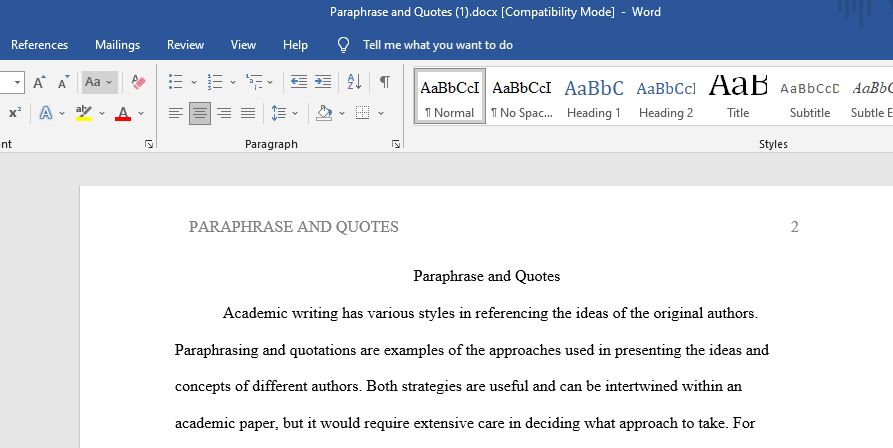What is the difference between paraphrasing and quoting?
STEP 1:
Please read the information below on paraphrasing vs quoting.
Last week, we read a few articles, and this week, we are going to read another. Later in the unit, we may use these articles as we write our own reflections and essays. Once you understand the ideas you are reading, you need to account for them in your own writing. Here is how:
THE IMPORTANCE OF PARAPHRASING
There are essentially two ways in which writers reference the ideas of others in their essays: paraphrase and direct quotation. You may already know this, but to paraphrase means to translate someone else’s ideas into your own words. Thus, with a paraphrase, you are still citing someone else’s ideas in your writing, and this is a critical aspect of academic writing.
The benefit of paraphrasing is that you keep control over the writing in your essay. Now, I’m not a control freak or anything, but remember that your essay is just that—your essay. Not Derrida’s or anyone else’s. Those people, most likely, have published many things before. This is your chance to share your opinion and develop your critical perspective.
And even if you’re not entirely interested in developing a critical perspective, paraphrasing helps you maintain the focus of your essay. By definition, paraphrasing involves shortening—cutting words that are not relevant to your point at hand. That is a powerful thing as a writer. You are still citing the ideas of someone else, but there is editorial judgement involved, because you must make decisions about what must stay and what can go. Paraphrasing is an important tool for academic writers because it allows you to get rid of the ideas not immediately relevant to your point at hand, but keep the ideas that are. This editorial judgement, however, should be done in an ethical way, meaning that you accurately present the original writer’s ideas and do not make them sound different than they actually are.
The following text summarizes the key points in the chapter so far, and offers guidelines that can help you decide when to directly quote and when to paraphrase a source text.
If someone’s ideas but not his/her exact words are important to your point, you should paraphrase rather than quote. A paraphrase should not change the ideas but it can eliminate or change words, often in order to condense a long sentence that contains details unnecessary to your point.
Quotation: In the short story “Thanks for the Ride,” Arnold Friend threatens Connie, the protagonist, by saying: “You come out here like a nice lady and give me your hand, and nobody else gets hurt, I mean your nice bald-headed daddy and your mummy and your sister in her high heels” (3).
Paraphrase: In the short story “Thanks for the Ride,” Arnold Friend warns Connie, the protagonist, that he will hurt her mother, father and sister if she doesn’t do what he wants.
GUIDELINES FOR SELECTING A QUOTATION:
Before you decide to use a quotation, ask yourself this question: Why am I using this passage? If you answer one of the following statements in the affirmative, you should use a direct quotation, not a paraphrase:
- I am quoting this passage because the author’s words are so impressive or so clever that to put them in my own words would lessen their impact.
- I am quoting this passage because the author’s words are so precise that to put them in my own words would change their meaning.
- I am quoting this passage because the author’s words are so concise that I would need twice as many words to paraphrase this passage.
If you answer “No” to those questions, you should paraphrase.
Now that you understand the distinction between summaries, quotations, and paraphrases, you are well on your way to writing from readings, or writing academically. The important idea from this section to remember is that academic writing does not happen in a vacuum or on an island (to mix metaphors). It is always in response to some kind of text or idea. Thus, it is critical that academic writers (i.e. students, YOU) cite those ideas in their own writing, using direct quotations and paraphrases, and then respond to those ideas. This process is known as an “academic conversation.”
STEP 2:
In a short one page journal, tell me what you understand about the difference between paraphrasing and quoting and include at least three takeaways or things you want to remember from this lecture.
Answer preview:

word limit:316
